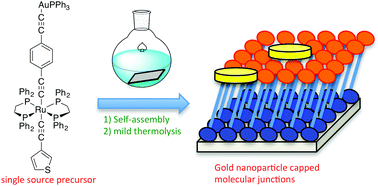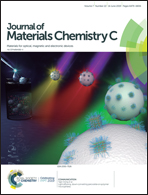Abstract
Methods for forming single- and multiple-molecule junctions are key to the development of molecular electronics and the further study of allied electronic and electrical properties of molecules arising from through-molecule charge transport. The organometallic complex trans-Ru(C![[triple bond, length as m-dash]](https://www.rsc.org/images/entities/char_e002.gif) C-3-C4H3S)(C
C-3-C4H3S)(C![[triple bond, length as m-dash]](https://www.rsc.org/images/entities/char_e002.gif) C-1,4-C6H4C
C-1,4-C6H4C![[triple bond, length as m-dash]](https://www.rsc.org/images/entities/char_e002.gif) CAuPPh3)(dppe)2 forms well-ordered, densely packed self-assembled monolayers on gold and silver substrates, contacted through the sulfur atoms of the thiophenyl groups. Upon mild thermal treatment (150–200 °C, two hours) the gold moiety decomposes to liberate PPh3 and form quite uniform, disc-shaped gold nanoparticles on top of the organometallic monolayer. The resulting molecular junctions give rise to sigmoidal shaped I–V curves characteristic of through-molecule conductance, rather than linear, ohmic traces associated with metallic contacts (i.e. short circuits). This work therefore demonstrates the feasibility of thermal processing routes to form good quality molecular junctions from organometallic complexes of relatively complex molecular structure capped with uniformly-shaped nanoparticles formed in situ.
CAuPPh3)(dppe)2 forms well-ordered, densely packed self-assembled monolayers on gold and silver substrates, contacted through the sulfur atoms of the thiophenyl groups. Upon mild thermal treatment (150–200 °C, two hours) the gold moiety decomposes to liberate PPh3 and form quite uniform, disc-shaped gold nanoparticles on top of the organometallic monolayer. The resulting molecular junctions give rise to sigmoidal shaped I–V curves characteristic of through-molecule conductance, rather than linear, ohmic traces associated with metallic contacts (i.e. short circuits). This work therefore demonstrates the feasibility of thermal processing routes to form good quality molecular junctions from organometallic complexes of relatively complex molecular structure capped with uniformly-shaped nanoparticles formed in situ.

- This article is part of the themed collection: Functional Organic Materials for Optoelectronic Applications


 Please wait while we load your content...
Please wait while we load your content...